Most Unusual Hopi Pueblo Jar by Nampeyo of Hano - C3942B
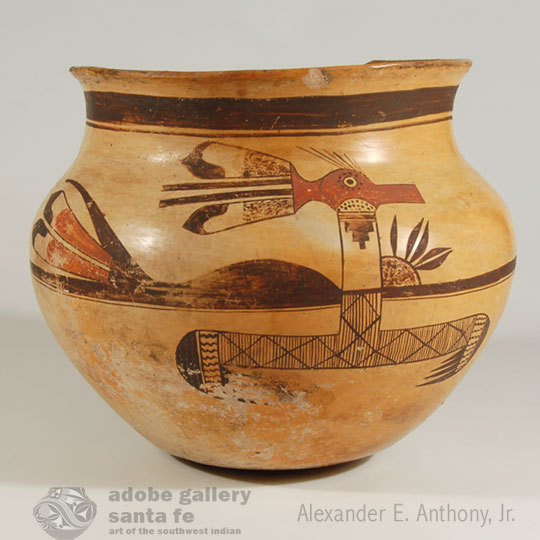 This jar shape is not what one normally associates with Hopi potters, yet there are jars in the Museum of Northern Arizona with similar shapes, both historic and contemporary. We just are not familiar with seeing such on a regular basis. It might be classified as a small storage jar. It has a rounded base like those of storage jars.
This jar shape is not what one normally associates with Hopi potters, yet there are jars in the Museum of Northern Arizona with similar shapes, both historic and contemporary. We just are not familiar with seeing such on a regular basis. It might be classified as a small storage jar. It has a rounded base like those of storage jars.
The bird flying on the neck of the jar has a rather squared off beak, which is not what we associate with Hopi birds but "There are a few odd bird heads on Nampeyo jars at the Museum of Northern Arizona." Personal note from Dr. Ed Wade. The polka-dot element below the bird's eye and the dark brown stepped cloud are most unusual elements on a bird's head.
Would like to purchase or read more about this Nampeyo pottery?
Hopi Pueblo Heheya Aumutaka Katsina Doll signed Mike - C3383ZK
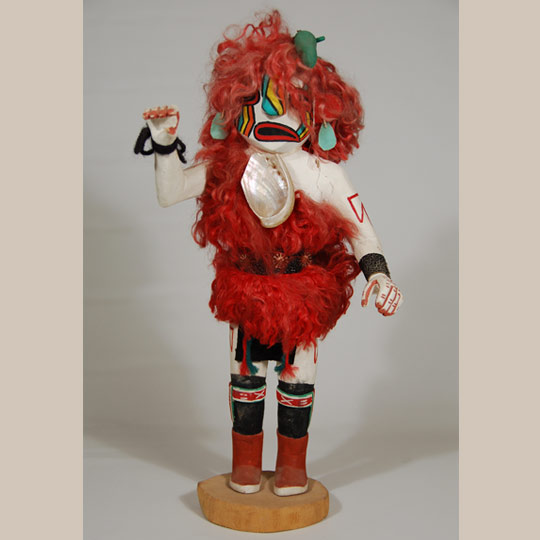 According to Barton Wright, Heheya Aumutaka means "like Heheya" and this version of Heheya appears only on Third Mesa. Other versions appear on First and Second Mesas. He is a relative of the Ogres, although he himself is not an Ogre. The interesting thing about this Katsina is that he speaks the opposite of what he means. If he says something is "good," he means it is "bad." Formerly he accompanied the Soyoko when they appeared on Third Mesa but since the Soyoko no longer come, his role is shifting to that of a general Powamu Katsina.
According to Barton Wright, Heheya Aumutaka means "like Heheya" and this version of Heheya appears only on Third Mesa. Other versions appear on First and Second Mesas. He is a relative of the Ogres, although he himself is not an Ogre. The interesting thing about this Katsina is that he speaks the opposite of what he means. If he says something is "good," he means it is "bad." Formerly he accompanied the Soyoko when they appeared on Third Mesa but since the Soyoko no longer come, his role is shifting to that of a general Powamu Katsina.
Would you like to purchase or read more about this Katsina?
#adobegallery #HopiPueblo #Katsina #Kachina # #Doll #SouthwestIndianArt #PuebloArt #SantaFeNM
Historic Kewa (Santo Domingo) Pueblo Decorated Deep Serving Bowl - C3924K
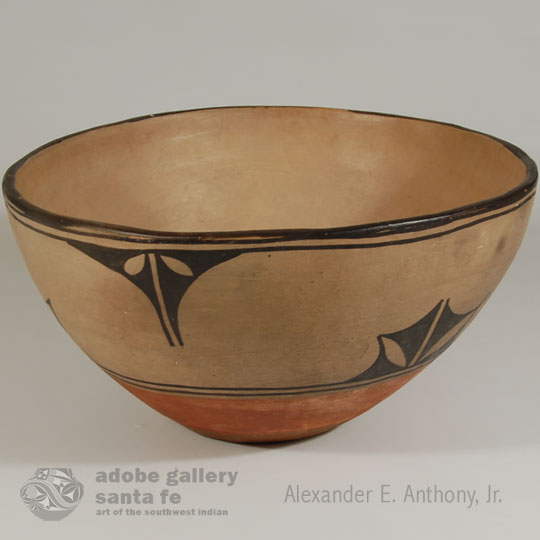 Kewa Pueblo food bowls assume the most beautiful patina from daily use. The cream slip with which they are coated absorbs the oils from foods and then turns a beautiful brown with an added sheen. Not only is the interior enhanced with an outstanding patina, the exterior assumes a patina from the hands of the handler. This one is no exception. It is the size bowl used for serving food at the table, not for eating from. This size is also used for preparation of bread dough when only a small amount of bread is being prepared.
Kewa Pueblo food bowls assume the most beautiful patina from daily use. The cream slip with which they are coated absorbs the oils from foods and then turns a beautiful brown with an added sheen. Not only is the interior enhanced with an outstanding patina, the exterior assumes a patina from the hands of the handler. This one is no exception. It is the size bowl used for serving food at the table, not for eating from. This size is also used for preparation of bread dough when only a small amount of bread is being prepared.
Would you like to purchase or read more about this pottery?
#adobegallery #SouthwestIndianPottery #KewaPueblo #KewaPottery #PuebloPottery #SouthwestIndianArt #SantaFePottery #FinePuebloPottery #HistoricPottery
Hopi Pueblo Seed Jar with Migration Pattern by Fannie Nampeyo - C3924Z
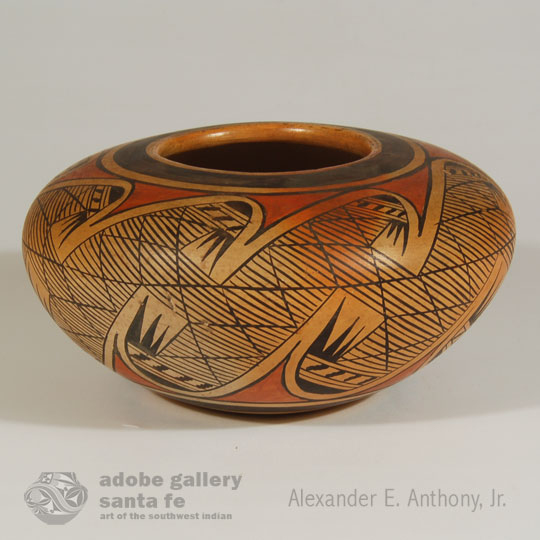 Fannie won her first Blue Ribbon in 1961 from the Museum of Northern Arizona at the annual Hopi Show. Her pottery was selected for several museum exhibits in the 1990s. Since she was the youngest daughter of Nampeyo and Lesou, she was better known, personally, by many collectors, most of whom never met Annie or Nellie. She was still actively making pottery in the mid-1980s.
Fannie won her first Blue Ribbon in 1961 from the Museum of Northern Arizona at the annual Hopi Show. Her pottery was selected for several museum exhibits in the 1990s. Since she was the youngest daughter of Nampeyo and Lesou, she was better known, personally, by many collectors, most of whom never met Annie or Nellie. She was still actively making pottery in the mid-1980s.
One of Fannie's favorite designs was the migration pattern-supposedly delineating the migration of the Hopi people through four worlds. Whether it was her favorite or whether she produced it because it was collectors' favorite is unknown, but it is the one she seems to have made more often.
Would you like to purchase or read more about this pottery?
Pictorial Design Bowl from the Hopi Mesas - C3925D
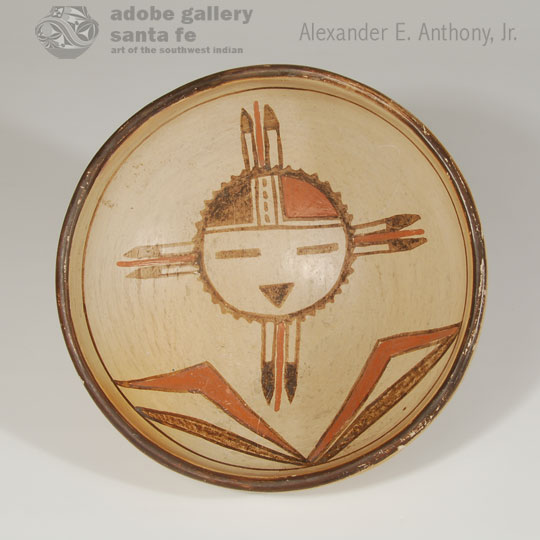 Before 1900, bowls such as this were routinely made for food. It would not have been decorated on the interior, however. After 1900, potters were encouraged by traders Thomas Keam and Lorenzo Hubbell to produce products for sale. Pictorial designs were particularly desirable as tourists were likely to prefer those over geometric designs.
Before 1900, bowls such as this were routinely made for food. It would not have been decorated on the interior, however. After 1900, potters were encouraged by traders Thomas Keam and Lorenzo Hubbell to produce products for sale. Pictorial designs were particularly desirable as tourists were likely to prefer those over geometric designs.
Hopi-Tewa Nampeyo of Hano Jar with Hopi Village Label - C3924C
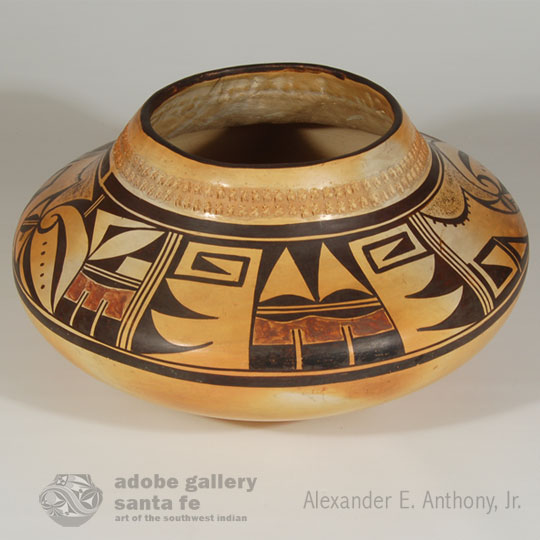 "Nequatewa states in his biography of Nampeyo that 'when she became a young maiden she was as good a potter as any in Walpi, and she did all the decorating for the old lady, her father's mother, a Tewa lady and her teacher, as she had become a good pottery designer.' He went on to say that 'when the stores were established on the reservation by the white traders, she was doing a good deal of pottery work, so that when the stores began to trade for pottery, her work was among the best, and she was getting good prices.'" Allen, 1984:21
"Nequatewa states in his biography of Nampeyo that 'when she became a young maiden she was as good a potter as any in Walpi, and she did all the decorating for the old lady, her father's mother, a Tewa lady and her teacher, as she had become a good pottery designer.' He went on to say that 'when the stores were established on the reservation by the white traders, she was doing a good deal of pottery work, so that when the stores began to trade for pottery, her work was among the best, and she was getting good prices.'" Allen, 1984:21
By 1900, the Polacca Polychrome pottery of the past was no longer being made, instead what replaced it was a yellow ware with black and red painted designs, with a slip that did not crackle like the Polacca slip. It was then that Nampeyo was encouraged to reproduce pottery of the style being excavated. She, instead, used those excavated ceramics as inspiration for her work. She was not interested in copying others.
Would like to purchase or read more about this pottery?
Hopi Pueblo Seed Jar with Whirling Log Design by Nampeyo of Hano - C3944
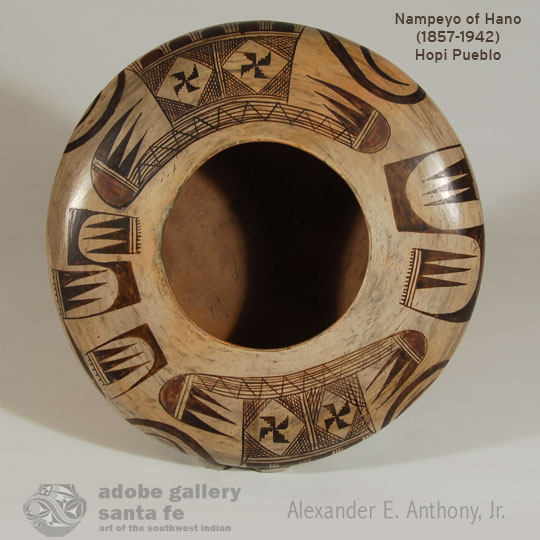 Nampeyo was an artistic genius. She was a Hopi-Tewa living at First Mesa who was going about her duties as a mother and wife, taking care of children, meals and making pottery for use in her home. Her talents in making pottery were early recognized by trader Thomas Keam, who, when he needed someone to make pottery for his business, chose Nampeyo. He recognized her as the best potter at Hopi.
Nampeyo was an artistic genius. She was a Hopi-Tewa living at First Mesa who was going about her duties as a mother and wife, taking care of children, meals and making pottery for use in her home. Her talents in making pottery were early recognized by trader Thomas Keam, who, when he needed someone to make pottery for his business, chose Nampeyo. He recognized her as the best potter at Hopi.
When one looks at this jar, there is no question that she was a great artist. It must qualify as one of the most creative and beautiful jars of the time. One can feel Nampeyo's presence when rubbing the inside of the rim of the jar where her hands formed the nearly flat top. There are probably fingerprints inside the rim.
Would you like to purchase or read more about this Hopi Pueblo pottery?
Beautifully Burnished San Ildefonso Solid Black Bowl by Maria Martinez - C3910F
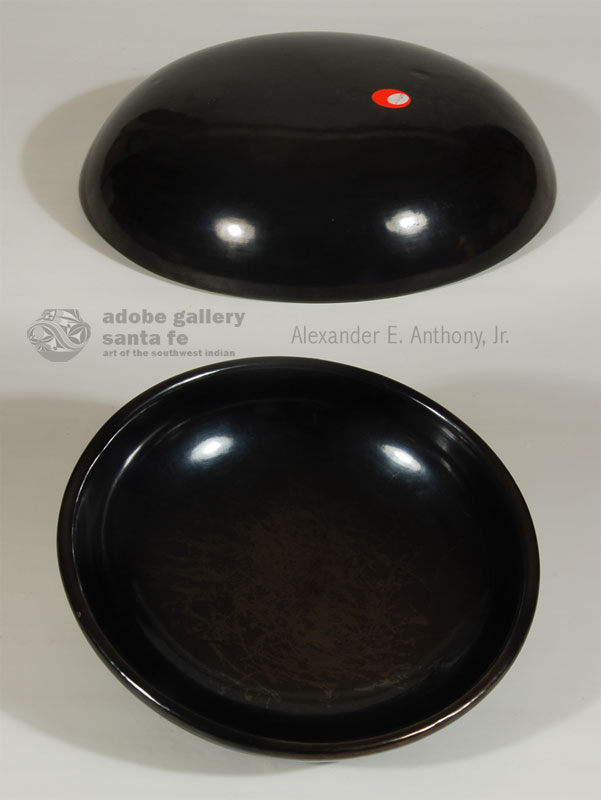 When Maria Martinez produced plain blackware without having a family member paint on a design, she signed her name as Maria Povéka. According to Richard Spivey, Maria started signing with the Maria Povéka name in 1956 when she began collaborating with Popovi Da. This was an attempt to distinguish between pottery she alone completed versus those that were collaborations with Popovi Da. Spivey states that Maria abandoned the Povéka signature in the mid-1960s. After that, all pieces were signed Maria/Popovi whether decorated or not. Spivey 2003
When Maria Martinez produced plain blackware without having a family member paint on a design, she signed her name as Maria Povéka. According to Richard Spivey, Maria started signing with the Maria Povéka name in 1956 when she began collaborating with Popovi Da. This was an attempt to distinguish between pottery she alone completed versus those that were collaborations with Popovi Da. Spivey states that Maria abandoned the Povéka signature in the mid-1960s. After that, all pieces were signed Maria/Popovi whether decorated or not. Spivey 2003
Kewa Pueblo Large Dough Bowl with Native Repairs - C3924i
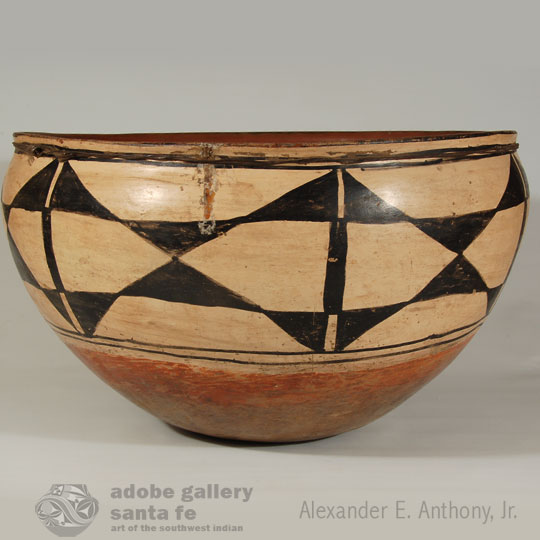 Native repairs on a pottery vessel is an indication of its importance to the owner as an item with which she would have need for household use. Minor cracks can be stabilized on a dough bowl such as this one by wrapping a wire or rawhide around the rim as a cinch. Additionally, the crack or cracks can be covered in piñon pitch as a sealant to prevent eventual chipping and worsening of the crack. This historic pottery bowl has both remedies. There is wire wrapped around the bowl just under the rolled-out rim and it has an elaborate hooking tie. There are remnants of piñon pitch over three vertical rim cracks. Most of the piñon has fallen off but enough remains to identify it.
Native repairs on a pottery vessel is an indication of its importance to the owner as an item with which she would have need for household use. Minor cracks can be stabilized on a dough bowl such as this one by wrapping a wire or rawhide around the rim as a cinch. Additionally, the crack or cracks can be covered in piñon pitch as a sealant to prevent eventual chipping and worsening of the crack. This historic pottery bowl has both remedies. There is wire wrapped around the bowl just under the rolled-out rim and it has an elaborate hooking tie. There are remnants of piñon pitch over three vertical rim cracks. Most of the piñon has fallen off but enough remains to identify it.
Traditional Hopi Pueblo Aya - Rattle Katsina Doll - C3535.56
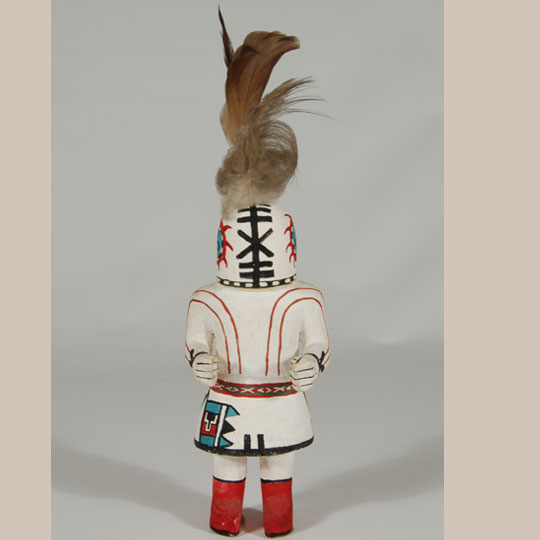 Many types of katsinas carry a rattle, called aaya or aya, in one hand when they participate in a plaza dance. The rattle is made from a dried, painted gourd and filled with pebbles or dry corn kernels and then fitted with a wooden handle. It makes a clattering sound as it is shaken.
Many types of katsinas carry a rattle, called aaya or aya, in one hand when they participate in a plaza dance. The rattle is made from a dried, painted gourd and filled with pebbles or dry corn kernels and then fitted with a wooden handle. It makes a clattering sound as it is shaken.
Aya Katsina is a katsina whose head looks like the brightly painted rattles that are among the gifts given by katsinas to children at Powamu and Niman ceremonies. The head of the Aya Katsina resembles the painted design found on gourd rattles.
Would you like to purchase or read more about this katsina doll?
Historic Zuni Pueblo Child Size Polychrome Jar with Heart Design - C3924R
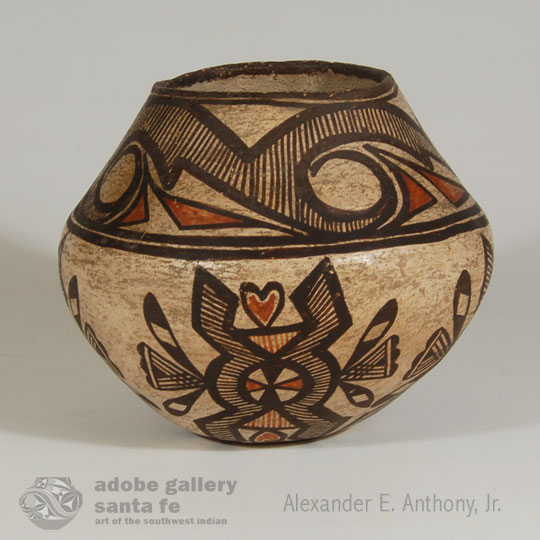 There is a charm to small pottery vessels that gets lost in larger size ones. Perhaps it is our association with small children and small animals that always attracts our attention. This small jar not only is charming, it has a most unusual and concentrated design pattern for its size. There are four design panels on the body that occupy the space from the shoulder to the base. Each of the four is densely compact with bold black lines, filled in with fine lines in black and red, rain clouds attached to the sides and hearts at the top and bottom. The neck design is a sweeping rain bird filled with fine lines.
There is a charm to small pottery vessels that gets lost in larger size ones. Perhaps it is our association with small children and small animals that always attracts our attention. This small jar not only is charming, it has a most unusual and concentrated design pattern for its size. There are four design panels on the body that occupy the space from the shoulder to the base. Each of the four is densely compact with bold black lines, filled in with fine lines in black and red, rain clouds attached to the sides and hearts at the top and bottom. The neck design is a sweeping rain bird filled with fine lines.
Hopi Pueblo Bowl with Narrow Design Band at Neck - C3926P
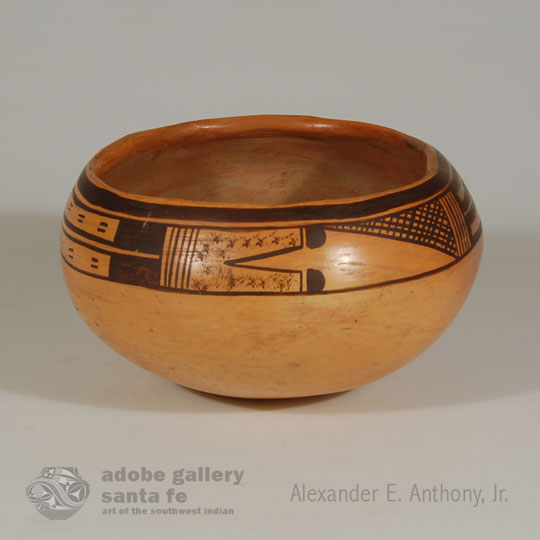 Collectors of contemporary pottery today are very interested in purchasing pieces that are signed by the artist. This was not true in the late 19th and early 20th centuries. It was sufficient to select a piece based on its personal appeal to the potential collector. Most of the late 19th and early 20th century pieces are not identified with a potter.
Collectors of contemporary pottery today are very interested in purchasing pieces that are signed by the artist. This was not true in the late 19th and early 20th centuries. It was sufficient to select a piece based on its personal appeal to the potential collector. Most of the late 19th and early 20th century pieces are not identified with a potter.
Most mid- to late-20th century pottery is signed with a potter's name, however, there are some in which the potter either failed to sign or perhaps was not able to write her name. The lack of a signature does not invalidate an item of pottery. It can be just as beautiful as one signed with a potter's name. Generally, an unsigned pottery vessel is less expensive but not less desirable.
Would you like to purchase or read more about this pottery?
Laguna Pueblo Historic Pitcher with Handle - 25992
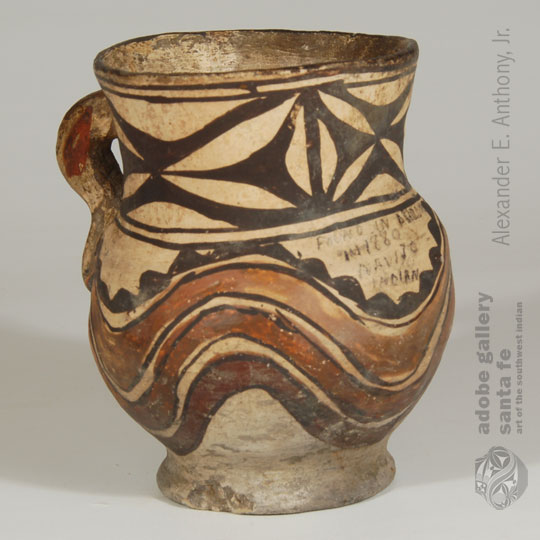 Written in pencil on the body of this pitcher is "Found in Acoma in 1880 Navajo Indian." Of course, this is not of Navajo origin and quite possibly might not be of Acoma origin, but is likely a product of Laguna Pueblo, and circa 1880 is a reasonable date to ascribe to it. It has a band of decoration painted in that deep red clay that has not generally been used since 1900.
Written in pencil on the body of this pitcher is "Found in Acoma in 1880 Navajo Indian." Of course, this is not of Navajo origin and quite possibly might not be of Acoma origin, but is likely a product of Laguna Pueblo, and circa 1880 is a reasonable date to ascribe to it. It has a band of decoration painted in that deep red clay that has not generally been used since 1900.
The dark red and dark orange rainbow bands, supplemented by dark brown designs, provide a design that is strong visually. It makes this small pottery vessel stand out among larger pieces that are weaker in color.
Would you like to purchase or read more about this pottery?
Bear Paw Symbol
Mary Mackie says: Bear Paw symbol in Pueblo pottery.
Mary Says: July 21, 2017 Getting Ready for the Hopi Show PART 1
Mary Says: July 21, 2017 Getting Ready for the Hopi Show
We are continuing to learn about Hopi pottery, about the genius of Nampeyo and her influence on the generations of young potters who have followed in her footsteps. As I look at each piece in the collection and at the new pieces that come to us, it is the scope of Nampeyo’s talent that seems to amaze me. She had an uncanny ability to use the pot, not just as a vessel, but as a canvas for her interpretation of things she saw, feelings she had, or just what she thought would please someone.
So, it’s really not hard to understand why, at the turn of the century, a great number of museums worldwide collected Nampeyo’s work. Nampeyo’s work is found in museums in Germany, England, Norway as well as numerous locations in the United States. Her artistic genius was recognized and appreciated by scholars worldwide.
So, now 100 years after she made them, her pieces are here at Adobe Gallery. I am thrilled to be able to look at and hold these incredible objects of art. When you look at her pieces, take the time to look at how her designs just fit the shape of the vessell perfectly.
-Mary Mackie
Mary Says: Getting Ready for the Hopi Pueblo Pottery Show PART 2
Anticipation around here is growing and on August 7th, 2017, the Hopi show will hit the shelves of Adobe Gallery. Ever since Al decided we were going to have a Hopi show, there seems to have been an uncanny series of coincidences. People we have never met somehow have found their way to us with Hopi treasures they no longer want. People we haven't heard from in years have contacted us looking for "that perfect Hopi pot" to complete their collection. Mark Tahbo has been on a creative streak, each piece he sends us is more and more amazing. Mark also shared some of the work of his cousin, Debbie Clashin.
For my part, I have gone back to reading about Hopi, I am fascinated by the stories of early visitors to Hopi and their interactions with Hopi potters. First is Thomas Keam. What possessed a young Englishman to leave his home, sail around the world, join the US Army and end up in a small canyon in Arizona? Arizona wasn't even a state when he arrived, the railroad was almost 10 years away. Yet, this young man learned two crazy difficult languages, Hopi and Navajo, married a Navajo woman and was responsible for the commercialization of Pueblo pottery. He was the starting point, in a way, in a long series of events that eventually leads to our show.
Here is a link to the show:
A Century of Hopi-Tewa Pottery: From Nampeyo of Hano to Mark Tahbo
San Ildefonso Eagle Dancers, Drummer, and Singer Painting by Quah Ah - C3928C
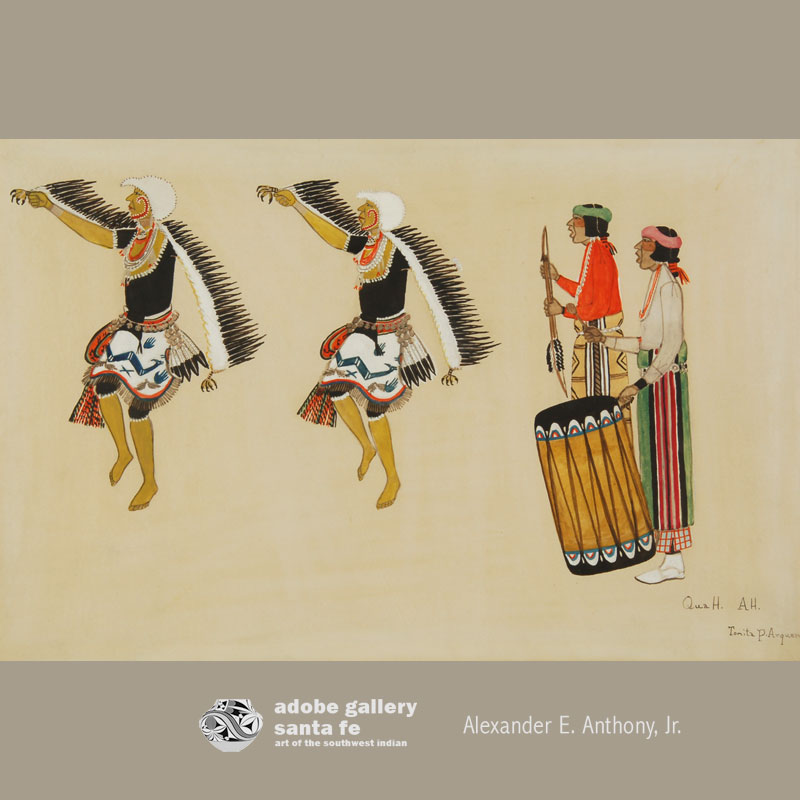 Tonita Vigil Peña (1893-1949) Quah Ah moved from San Ildefonso Pueblo to Cochiti Pueblo when her mother passed away. She was only 12 years old at the time and she then lived with her aunt and uncle until she married at age 15. She lived at Cochiti for the remainder of her life and passed away in 1949.
Tonita Vigil Peña (1893-1949) Quah Ah moved from San Ildefonso Pueblo to Cochiti Pueblo when her mother passed away. She was only 12 years old at the time and she then lived with her aunt and uncle until she married at age 15. She lived at Cochiti for the remainder of her life and passed away in 1949.
By the time Tonita was 25 years old, she was a successful easel artist, and her work was being shown in museum exhibitions and in commercial art galleries in Santa Fe and Albuquerque. She painted what she knew best - scenes of life at the pueblo - mostly ceremonial dances and everyday events. She is still considered one of the best female Indian artists of all time.
Would you like to purchase or read more about this painting?
Very Large Zia Pueblo Dough Bowl with Floral Design - C3924H
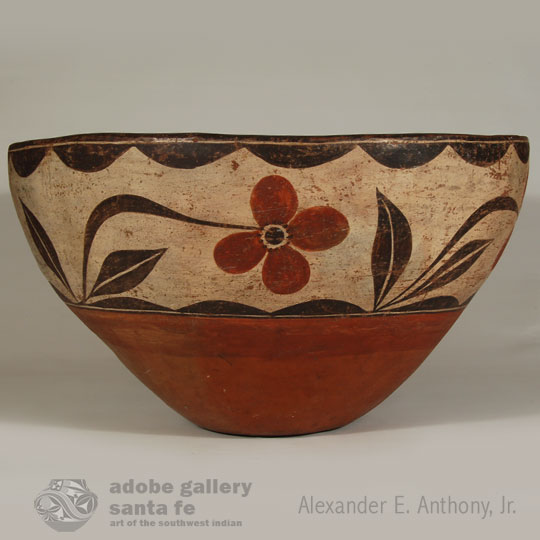 The chapter devoted to dough bowls in the book The Pottery of Zia Pueblo (see reference link below) does not show any examples of dough bowls with floral designs although they do show dough bowls dating as late as 1940. This dough bowl has all the attributes of a circa 1880 dough bowl, except perhaps for its design. We maintain that collections made by the Smithsonian and other museums in the late 1800s possibly overlooked bowls with floral designs in preference for those with Trios Polychrome designs.
The chapter devoted to dough bowls in the book The Pottery of Zia Pueblo (see reference link below) does not show any examples of dough bowls with floral designs although they do show dough bowls dating as late as 1940. This dough bowl has all the attributes of a circa 1880 dough bowl, except perhaps for its design. We maintain that collections made by the Smithsonian and other museums in the late 1800s possibly overlooked bowls with floral designs in preference for those with Trios Polychrome designs.
"The large four-petaled red flowers. . . placed on long, curving stems, have other parallels that may be dated before 1887. Harlow & Lanmon 2003 p.210. There are many Zia jars from the late 1800s with floral designs so it is not unexpected that the design would be used on dough bowls too.
Would you like to purchase or read more about this historic Zia pottery?
Hopi Pueblo Mongwa Great Horned Owl Katsina Doll by Otto Pentewa - C3383ZM
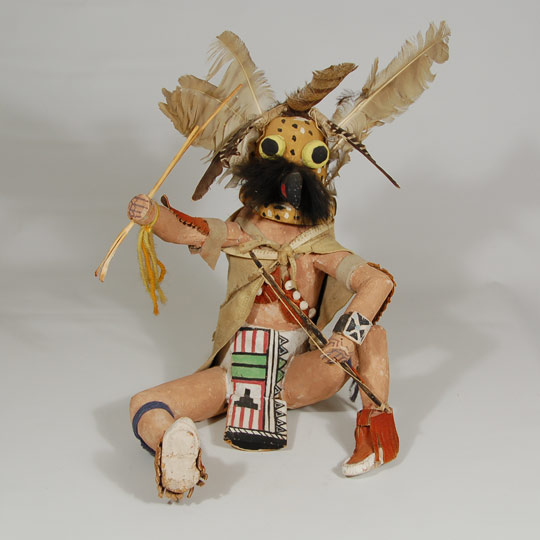 The Great Horned Owl Katsina, as a warrior, is relentless in persecuting the clowns. He stands to the edge of the dance circle while the clowns are performing and he watches disapprovingly of their antics as they perform their un-Hopi-behavior. Near the end of the dance, a group of Mongwa swoops down on the clowns and beat them with yucca whips, douses them with water, and leaves them piled up in the center of the plaza in pain.
The Great Horned Owl Katsina, as a warrior, is relentless in persecuting the clowns. He stands to the edge of the dance circle while the clowns are performing and he watches disapprovingly of their antics as they perform their un-Hopi-behavior. Near the end of the dance, a group of Mongwa swoops down on the clowns and beat them with yucca whips, douses them with water, and leaves them piled up in the center of the plaza in pain.
This carving of a Mongwa features him with a yucca whip in one hand and a bow in the other. He appears to be waiting until the clowns finish their dance. This is an elaborate carving and is probably no later than the 1940s, perhaps earlier. It is primitive in a way but charming as well. It is not signed with the name of a carver but does have the notation K-7 painted on the underside.
Would you like to purchase or read more about this katsina doll?
Hopi Pueblo Katsina - Kachina Doll with Bird Beak - 26003
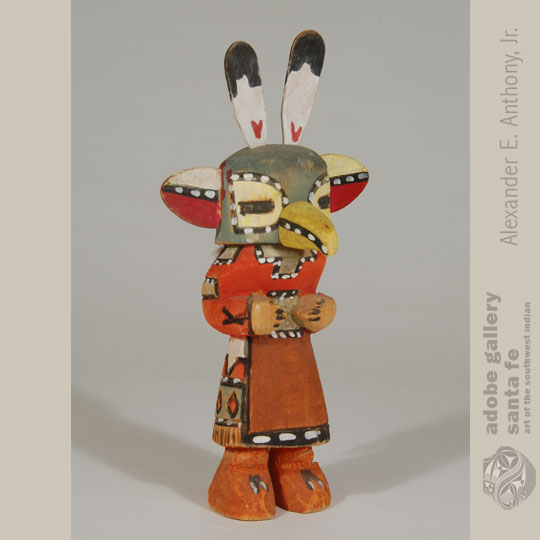 Some of the older Hopi men had difficulty reconciling making traditional katsina dolls to be sold to tourists because of conflicts with the traditional meaning of the dolls to the Hopi people. Katsina dolls were made as gifts from the Katsinam to the Hopi females as a means of including them in the Katsinam ceremonies that were practiced by the Hopi men. To some of the older men, carving the dolls for sale was degrading and perhaps sacrilegious to their meaning. Wilson Tawaquaptewa was one of the most famous carvers with such feelings.
Some of the older Hopi men had difficulty reconciling making traditional katsina dolls to be sold to tourists because of conflicts with the traditional meaning of the dolls to the Hopi people. Katsina dolls were made as gifts from the Katsinam to the Hopi females as a means of including them in the Katsinam ceremonies that were practiced by the Hopi men. To some of the older men, carving the dolls for sale was degrading and perhaps sacrilegious to their meaning. Wilson Tawaquaptewa was one of the most famous carvers with such feelings.
To prevent defying their religious beliefs in the Katsina culture, yet, to be able to participate in the money-making business of selling katsina dolls to tourists, some of these men made dolls that did not accurately reflect the true katsinas. The carvings looked like authentic katsinas but were not accurate in the portrayal of a specific katsina. They may have had features of several katsinas combined to appear to reflect an existing katsina but did not violate their belief in the meaning of true katsinas.
Would you like to purchase or read more about this katsina doll?


